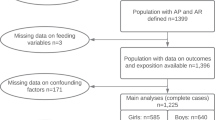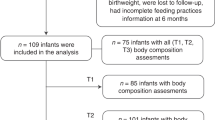Abstract
Background/Objectives:
Breastfeeding has a protective effect on childhood obesity, but the influences on body composition in early childhood are not known. The objective of this study is to assess whether the duration and exclusiveness of breastfeeding, and the timing of introduction of solid foods are associated with the subcutaneous fat mass in early childhood.
Subjects/Methods:
This study was embedded in a population-based prospective cohort study among 779 children. Peripheral (biceps, triceps) and central (suprailiacal and subscapular) subcutaneous fat mass was measured as skinfold thickness at the ages of 1.5, 6 and 24 months.
Results:
Breastfeeding duration was not associated with subcutaneous fat mass at the age of 1.5 months. Shorter breastfeeding was associated with higher peripheral and total subcutaneous fat mass at the age of 6 months (P-value for trend <0.05), but not at the age of 24 months. As compared to children who were exclusively breast fed for 4 months, those who were non-exclusively breast fed had a higher central fat mass at the age of 24 months (P-value for trend <0.01). Timing of introduction of solid foods was not associated with subcutaneous fat mass.
Conclusion:
Our results suggest that a shorter duration and non-exclusive breastfeeding affect early body composition during the first 2 years of life. Follow-up studies at older ages are needed to explore the long-term consequences.
This is a preview of subscription content, access via your institution
Access options
Subscribe to this journal
Receive 12 print issues and online access
$259.00 per year
only $21.58 per issue
Buy this article
- Purchase on Springer Link
- Instant access to full article PDF
Prices may be subject to local taxes which are calculated during checkout

Similar content being viewed by others
References
Agostoni C, Decsi T, Fewtrell M, Goulet O, Kolacek S, Koletzko B et al. (2008). Complementary feeding: a commentary by the ESPGHAN Committee on Nutrition. J Pediatr Gastroenterol Nutr 46, 99–110.
Arenz S, Rückerl R, Koletzko B, von Kries R (2004). Breast-feeding and childhood obesity—a systematic review. Int J Obes Relat Metab Disord 28, 1247–1256.
Ay L, Hokken-Koelega AC, Mook-Kanamori DO, Hofman A, Moll HA, Mackenbach JP et al. (2008). Tracking and determinants of subcutaneous fat mass in early childhood: the Generation R Study. Int J Obes (Lond) 32, 1050–1059.
Ay L, Van Houten VA, Steegers EA, Hofman A, Witteman JC, Jaddoe VW et al. (2009). Fetal and postnatal growth and body composition at 6 months of age. J Clin Endocrinol Metab 94, 2023–2030.
Baird J, Poole J, Robinson S, Marriott L, Godfrey K, Cooper C et al. (2008). Milk feeding and dietary patterns predict weight and fat gains in infancy. Paediatr Perinat Epidemiol 22, 575–586.
Bergmann KE, Bergmann RL, Von Kries R, Böhm O, Richter R, Dudenhausen JW et al. (2003). Early determinants of childhood overweight and adiposity in a Birth Cohort Study: role of breast-feeding. Int J Obes Relat Metab Disord 27, 162–172.
Birmingham B, Dyer AR, Shekelle RB, Stamler J (1993). Subscapular and triceps skinfold thicknesses, body mass index and cardiovascular risk factors in a cohort of middle-aged employed men. J Clin Epidemiol 3, 289–302.
Bland JM, Altman DG (1986). Statistical methods for assessing agreement between two methods of clinical measurement. Lancet 1, 307–310.
Burdette HL, Whitaker RC, Hall WC, Daniels SR (2006). Breastfeeding, introduction of complementary foods, and adiposity at 5 y of age. Am J Clin Nutr 83, 550–558.
Durmuş B, van Rossem L, Duijts L, Arends LR, Raat H, Moll HA et al. (2011). Breast-feeding and growth in children until the age of 3 years: the Generation R Study. Br J Nutr 31, 1–9.
Forsyth JS, Ogston SA, Clark A, Florey CD, Howie PW (1993). Relation between early introduction of solid food to infants and their weight and illnesses during the first two years of life. BMJ 306, 1572–1576.
Fox CS, Massaro JM, Hoffmann U, Pou KM, Maurovich-Horvat P, Liu CY et al. (2007). Abdominal visceral and subcutaneous adipose tissue compartments: association with metabolic risk factors in the Framingham Heart Study. Circulation 116, 39–48.
Gale CR, Javaid MK, Robinson SM, Law CM, Godfrey KM, Cooper C (2007). Maternal size in pregnancy and body composition in children. J Clin Endocrinol Metab 92, 3904–3911.
Harder T, Bergmann R, Kallischnigg G, Plagemann A (2005). Duration of breastfeeding and risk of overweight: a meta-analysis. Am J Epidemiol 163, 397–403.
Jaddoe VW, van Duijn CM, van der Heijden AJ, Mackenbach JP, Moll HA, Steegers EA et al. (2010). The Generation R Study: design and cohort update 2010. Eur J Epidemiol 25, 823–841.
Ketel IJ, Volman MN, Seidell JC, Stehouwer CD, Twisk JW, Lambalk CB (2007). Superiority of skinfold measurements and waist over waist-to-hip ratio for determination of body fat distribution in a population-based cohort of Caucasian Dutch adults. Eur J Endocrinol 6, 655–661.
Kramer MS (1981). Do breast-feeding and delayed introduction of solid foods protect against subsequent obesity? J Pediatr 98, 883–887.
Li R, Scanlon KS, Serdula MK (2005). The validity and reliability of maternal recall of breastfeeding practice. Nutr Rev 63, 103–110.
Lohman TG, Roche AF, Martorell R (1991). Anthropometric Standardization Reference Manual: Abridged Edition. Human Kinetics Books: Champaign, IL.
Morgan JB, Lucas A, Fewtrell MS (2004). Does weaning influence growth and health up to 18 months? Arch Dis Child 89, 728–733.
Nevill AM, Stewart AD, Olds T, Holder R (2006). Relationship between adiposity and body size reveals limitations of BMI. Am J Phys Anthropol 129, 151–156.
Noble S, Emmett P (2006). Differences in weaning practice, food and nutrient intake between breast- and formula-fed 4-month-old infants in England. J Hum Nutr Diet 19, 303–313.
Nohr EA, Frydenberg M, Henriksen TB, Olsen J (2006). Does low participation in cohort studies induce bias? Epidemiology 17, 413–418.
Owen CG, Martin RM, Whincup PH, Davey-Smith G, Gillman MW, Cook DG (2005a). The effect of breastfeeding on mean body mass index throughout life: a quantitative review of published and unpublished observational evidence. Am J Clin Nutr 82, 1298–1307.
Owen CG, Martin RM, Whincup PH, Smith GD, Cook DG (2005b). The effect of infant feeding on the risk of obesity across the life course: a quantitative review of published evidence. Pediatrics 115, 1367–1377.
Pischon T, Boeing H, Hoffmann K, Bergmann M, Schulze MB, Overvad K et al. (2008). General and abdominal adiposity and risk of death in Europe. N Engl J Med 359, 2105–2120.
Robinson SM, Marriott LD, Crozier SR, Harvey NC, Gale CR, Inskip HM et al. (2009). Variations in infant feeding practice are associated with body composition in childhood: A Prospective Cohort Study. J Clin Endocrinol Metab 94, 2799–2805.
Scott JA, Binns CW, Graham KI, Oddy WH (2009). Predictors of the early introduction of solid foods in infants: results of a Cohort Study. BMC Pediatr 9, 60.
Shrout PE, Fleiss JL (1979). Intraclass correlations: uses in assessing rater reliability. Psychol Bull 86, 420–428.
Statistics Netherlands (2004). Standaard onderwijsindeling 2003. Statistics Netherlands: Voorburg/Heerlen.
Toschke AM, Martin RM, von Kries R, Wells J, Smith GD, Ness AR (2007). Infant feeding method and obesity: body mass index and dual-energy X-ray absorptiometry measurements at 9–10 y of age from the Avon Longitudinal Study of Parents and Children (ALSPAC). Am J Clin Nutr 85, 1578–1585.
Tulldahl J, Pettersson K, Andersson SW, Hulthén L (1999). Mode of infant feeding and achieved growth in adolescence: early feeding patterns in relation to growth and body composition in adolescence. Obes Res 7, 431–437.
Victora CG, Barros F, Lima RC, Horta BL, Wells J (2003). Anthropometry and body composition of 18 year old men according to duration of breast feeding: Birth Cohort Study from Brazil. BMJ 327, 901.
Wells JC, Chomtho S, Fewtrell MS (2007). Programming of body composition by early growth and nutrition. Proc Nutr Soc 66, 423–434.
Wells JC, Fewtrell MS (2006). Measuring body composition. Arch Dis Child 91, 612–617.
WHO Multicentre Growth Reference Study Group (2006). Reliability of anthropometric measurements in the WHO Multicentre Growth Reference Study. Acta Paediatr 450, 8–46.
Wilson AC, Forsyth JS, Greene SA, Irvine L, Hau C, Howie PW (1998). Relation of infant diet to childhood health: seven year follow up of cohort of children in Dundee Infant Feeding Study. BMJ 316, 21–25.
Wright CM, Parkinson KN, Drewett RF (2004). Why are babies weaned early? Data from a prospective Population Based Cohort Study. Arch Dis Child 89, 813–816.
Zive MM, McKay H, Frank-Spohrer GC, Broyles SL, Nelson JA, Nader PR (1992). Infant-feeding practices and adiposity in 4-y-old Anglo- and Mexican-Americans. Am J Clin Nutr 55, 1104–1108.
Acknowledgements
The Generation R Study is conducted by the Erasmus Medical Center in close collaboration with the School of Law and Faculty of Social Sciences of the Erasmus University Rotterdam, the Municipal Health Service Rotterdam area, Rotterdam, the Rotterdam Homecare Foundation, Rotterdam and the Stichting Trombosedienst and Artsenlaboratorium Rijnmond (STAR), Rotterdam. We gratefully acknowledge the contribution of participating mothers, general practitioners, hospitals, midwives and pharmacies in Rotterdam. The first phase of the Generation R Study is made possible by financial support from the Erasmus Medical Center, Rotterdam, the Erasmus University Rotterdam and the Netherlands Organization for Health Research and Development. The study sponsors had no role in study design, data analysis, interpretation of data or writing this report. Vincent Jaddoe received an additional grant from the Netherlands Organization for Health Research and Development (ZonMw 90700303, 916.10159). B Durmuş was supported by an unrestricted grant from the Danone Research.
Author information
Authors and Affiliations
Corresponding author
Ethics declarations
Competing interests
The authors declare no conflict of interest.
Additional information
Supplementary Information accompanies the paper on European Journal of Clinical Nutrition website
Supplementary information
Rights and permissions
About this article
Cite this article
Durmuş, B., Ay, L., Duijts, L. et al. Infant diet and subcutaneous fat mass in early childhood: The Generation R Study. Eur J Clin Nutr 66, 253–260 (2012). https://doi.org/10.1038/ejcn.2011.174
Received:
Revised:
Accepted:
Published:
Issue Date:
DOI: https://doi.org/10.1038/ejcn.2011.174
Keywords
This article is cited by
-
Association between perinatal factors, genetic susceptibility to obesity and age at adiposity rebound in children of the EDEN mother–child cohort
International Journal of Obesity (2021)
-
Influence of breastfeeding on retinal vessel calibers in school-age children. The Generation R Study
European Journal of Clinical Nutrition (2016)
-
Infant diet and metabolic outcomes in school-age children. The Generation R Study
European Journal of Clinical Nutrition (2014)
-
Catch up growth in low birth weight infants: Striking a healthy balance
Reviews in Endocrine and Metabolic Disorders (2012)



